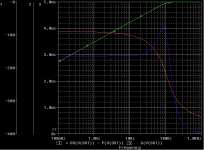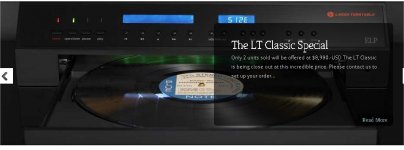??? No, SK is a conventional min phase filter, with normal group delay........
That's what I said you can't have max 2.5mS GD change with a 20Hz min phase filter.
If you amplify then digitally EQ an RIAA signal it has the same overload issues as the all analog topology using the same approach. Getting 40 dB OLM on a 3mV input with the benchmark 79 dB S/N is quite doable on +-15 V rails (150mV output). Amplifying and then EQ'ing loses 18 dB of headroom. I have to agree with Self here: The trick is to place the gain and EQ round the first stage for the best results.
OK, so irrelevant to coupling caps.
Why are the BP types much higher in THD than regular polar types when there is voltage across them?
THx-RNMarsh
Just harking back to low distortion at deep bass frequencies for a second, this appears to be a very high quality bass driver, accuton® Carefully selected loudspeaker drivers., with quite impressive FR, 3rd harmonic distortion, and price! Yet, the 2nd harmonic flies off the chart between 40 and 50Hz, meaning all frequencies in this region and below will be highly "enriched" with at least 2nd harmonics, nicely adding to the subjective experience.
Can anyone offer a driver that can do better than this unit, in terms of raw distortion performance?
Can anyone offer a driver that can do better than this unit, in terms of raw distortion performance?
That's interesting.
I always thought that it is better (in terms of headroom) to do the HF roll off in analog before the AD but I hadn’t thought that the all-digital RIAA has this benefit:
Doing the deemphasis in the digital domain, we lose in dynamic range, (but) the disadvantage is balanced by the complementary enhancement of digital resolution, due to treble preemphasis (as treble is of higher amplitude), in the frequency range where human hearing is at its most sensitive.
George
Of course, but I think the loss is more related to the loss in gain due to accommodating a higher crest factor input. I'm not totally satisfied with the Channel D arguments based on ideal quantizers alone but their recording survey begins to address other aspects of the issue. They do sell their pre-amps, etc. for silly money (Mac users) but their success would indicate that the concept is not totally bankrupt. I seriously doubt it is an "effects box" that just sounds different.
Because they're electrolytics. They can work fine in coupling applications, less fine in filters.
I think that's been mentioned here, oh, once or twice.
When voltage is dropped across BP electrolytics---> Why are the bipolar electrolyticss much higher in THD than the polar electrolytic type, SY??
THx-RNMarsh
Last edited:
That's what I said you can't have max 2.5mS GD change with a 20Hz min phase filter.
I have seen this number related to bass and to 100Hz in particular.... must be well established. Here is one well known company which again quote 2.5mS at 100 Hz. We can use that for now, IMO, for lowr freqs as well. I would suspect though that at 20Hz it could be relaxed some. I'll drop it off when it comes by again.
Georg Neumann GmbH - Professional Monitoring
View attachment 8053.PDF
-RNM
Last edited:
I agree, although for reasons of my own I prefer to do only the 75us tau in the first stage.If you amplify then digitally EQ an RIAA signal it has the same overload issues as the all analog topology using the same approach. Getting 40 dB OLM on a 3mV input with the benchmark 79 dB S/N is quite doable on +-15 V rails (150mV output). Amplifying and then EQ'ing loses 18 dB of headroom. I have to agree with Self here: The trick is to place the gain and EQ round the first stage for the best results.
I don't know why the gain + passive EQ + gain has been considered such an advance.
In the design underway here, the first stage is a first-order lowpass at 2122Hz (the 75us tau). Then a shelf following accomplishes the correction to standard RIAA.
OTOH there is the possibility of the hybrid approach with one analog time constant that can be trimmed totally independently of the digital ones. There is an over attraction to the digital side i.e. a simple biquad IIR at 96k is +-.003db and 2 degrees of phase at 20k
Last edited:
Just doing some numbers, let's say the driver is fed a 30Hz sine to produce around 90dB. At that frequency the Accuton would be producing at least 10% 2nd, as a rough guess, 60Hz accoustic energy 20db down from the fundamental. But, now the equal-loudness contour enters the scene to bite you, and looking at the curves, Equal-loudness contour - Wikipedia, the free encyclopedia, at those sound levels the ear hears an almost 20dB lower 60Hz sine as being equally loud to a 30Hz one!Just harking back to low distortion at deep bass frequencies for a second, this appears to be a very high quality bass driver, accuton® Carefully selected loudspeaker drivers., with quite impressive FR, 3rd harmonic distortion, and price! Yet, the 2nd harmonic flies off the chart between 40 and 50Hz, meaning all frequencies in this region and below will be highly "enriched" with at least 2nd harmonics, nicely adding to the subjective experience.
So, the driver producing a 30Hz note also sends out a 60Hz tone, subjectively only slightly less intense than the 30Hz tone - an extremely enriched listening experience I would say ...
I have seen this number related to bass and to 100Hz in particular.... must be well established. Here is one well known company which again quote 2.5mS at 100 Hz. We can use that for now, IMO, for lowr freqs as well. I would suspect though that at 20Hz it could be relaxed some. I'll drop it off when it comes by again.
Georg Neumann GmbH - Professional Monitoring
-RNM
Grrrrr.... 100Hz is NOT 20Hz. A 3rd order Sallen-Key can approach those 2.5mSec group delay at 100Hz (although I don't see why a 3rd order is required, since we are no longer talking about a TT subsonic filter).
Mr. Marsh, wouldn't be a good idea to reverse the order, search and read first on the topic, then come up with something that is at least pre-chewed? Really, you are wasting precious electrons posting absurd numbers.
Attachments
When voltage is dropped across BP electrolytics---> Why are the bipolar electrolyticss much higher in THD than the polar electrolytic type, SY??
Are you asking for basic references?
ONE BIG QUESTION
Why hasn't anyone just gone out and created an analog disc that was 50KHz or 75KHz
bandwidth per channel read it with a laser and be done with all the digital stuff that
claims 24 bit...Why not just put the real thing down optically and read it with
a laser. Heck we used to put audio tracks on the NTSCs Raster Scan lines for longer
playback etc. .
Yup - It's been done.
Here- ELP Laser Turntable |
3 lasers to track , 2 to read. Adjustable read depth for worn LP's.
Below -
OS
Attachments
Maybe a dodgy 11 bits is plenty?
I suspect the SNR at the disk surface at 20Hz is lucky to be 11bits. No Maxwell's demons allowed in an analog pre-amp the surface noise is amplified by 40dB just like the signal. Digitizing the combination at more bits does not gain SNR.
Yup - It's been done.
Here- ELP Laser Turntable |
3 lasers to track , 2 to read. Adjustable read depth for worn LP's.
Below -
OS
A laser turntable has the same speed, warp, and eccentricity problems as an analog one. The actual groove velocity is an analog thing. But not the stylus tracking distortion, I hope Jan finds out something interesting.
Last edited:
Speaking of resolution---do any 24 bit audio bandwidth ADCs actually do something approaching 24 bits without missing codes?I suspect the SNR at the disk surface at 20Hz is lucky to be 11bits. No Maxwell's demons allowed in an analog pre-amp the surface noise is amplified by 40dB just like the signal. Digitizing the combination at more bits does not gain SNR.
- Status
- Not open for further replies.
- Home
- Member Areas
- The Lounge
- John Curl's Blowtorch preamplifier part II

